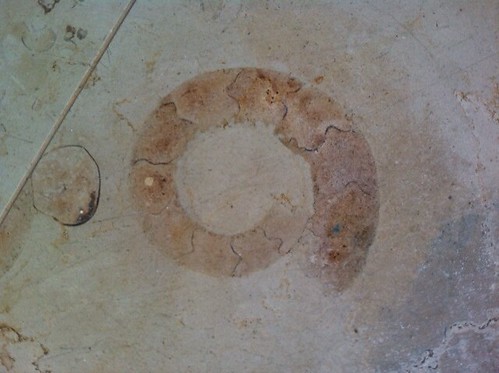
Amonites em Riachos!

Os fósseis (palavra derivado do termo latino fossilis que significa "desenterrado" ou "extraído da terra") são restos de seres vivos ou evidências de suas atividades biológicas preservados em diversos materiais. Essa preservação ocorre principalmente em rochas, mas pode ocorrer também em materiais como sedimentos, gelo, resinas, solos e cavernas e os exemplos mais citados são ossos e caules fossilizados, conchas, ovos e pegadas. Os fósseis fornecem dados importantes quanto a evolução biológica, datação e reconstituição da história geológica da Terra.
Amonites são um grupo extinto de animais invertebrados marinhos na subclasse Ammonoidea da classe dos Cefalópodes. Esses moluscos são mais estreitamente relacionados aos coleoidea vivos (ou seja, polvos, lulas e chocos) do que são para os nautiloids de casca tais como as espécies vivas de Nautilus. Os primeiros amonites apareceram durante o Devoniano, e as últimas espécies desapareceram durante o evento de extinção Cretáceo-Paleogeno.
Amonites são excelentes fósseis de índice, e muitas vezes é possível ligar a camada de rocha em que uma espécie ou género específico é encontrado a períodos específicos de tempo geológico. As suas conchas fósseis geralmente tomam a forma de planispirals, embora houvesse algumas formas de hélice em espiral e não espiral (conhecidos como heteromorphs).
O nome "amonite", a partir do qual o termo científico é derivado, foi inspirado pela forma espiral de suas conchas fossilizadas, que se assemelham fortemente a chifres de carneiro enrolados.

Fossil (word derived from the Latin word fossilis meaning "dug up" or "extracted from the earth") are the remains of living organisms or evidence of their biological activity preserved in various materials. This preservation occurs mainly in rocks, but can also occur in materials such as sediments, ice, resins, soils and caves and the most cited examples are bones and fossilized stems, shells, eggs and footprints. Fossils provide important data regarding biological evolution, dating and reconstructing the geologic history of the Earth.
Ammonites are an extinct group of marine invertebrate animals in the subclass Ammonoidea of the class Cephalopoda. These molluscs are more closely related to living coleoids (i.e. octopuses, squid, and cuttlefish) than they are to shelled nautiloids such as the living Nautilus species. The earliest ammonites appear during the Devonian, and the last species died out during the Cretaceous–Paleogene extinction event.
Ammonites are excellent index fossils, and it is often possible to link the rock layer in which a particular species or genus is found to specific geological time periods. Their fossil shells usually take the form of planispirals, although there were some helically spiraled and nonspiraled forms (known as heteromorphs).
The name "ammonite", from which the scientific term is derived, was inspired by the spiral shape of their fossilized shells, which somewhat resemble tightly coiled rams' horns.
A Cache

Esta Earthcache leva-o a encontrar fósseis de Amonite num local muito improvável, numa rocha que foi utilizada para a construção pelo ser humano.
Para poder fazer o Found desta Earthcache terá de nos enviar um e-mail através do nosso perfil com o seguinte:
- Na etapa 1 (coordenadas iniciais), qual é o diâmetro da Amonite que vais observar?
- Observando a Amonite, consegues dizer se está completa ou incompleta?
- Na etapa 2, quantas amonites consegues observar, por detrás do pilar?
- As amonites que vês estão completas ou incompletas?
Fotos no log serão sempre bem-vindas, mas por favor não coloquem fotos que revelem as respostas da Earthcache!
Depois de enviar as respostas pode fazer o log, caso exista alguma dúvida em relação às respostas dadas serão contactados para a esclarecer.

This EarthCache leads you to find a ammonite fóssil in a very unlikely place, a rock that was used for the construction by the human being.
In order to make the Found of this Earthcache you have to send a e- mail via our profile with the following:
- In step1 (inicial coordinates), what is the diameter of the Ammonite, that you are observing?
- Looking at Ammonite, can you tell if it's complete or incomplete?
- In step 2 how many ammonites can you observe behind the pillar?
- The ammonites that you see are complete or incomplete?
Photos in the log are always welcome, but please do not post photos that show the answers of the Earthache!
After sending the answers by e-mail you can log the Earthcache. If there is any doubt regarding the answers you will be contacted to clarify it.

